-
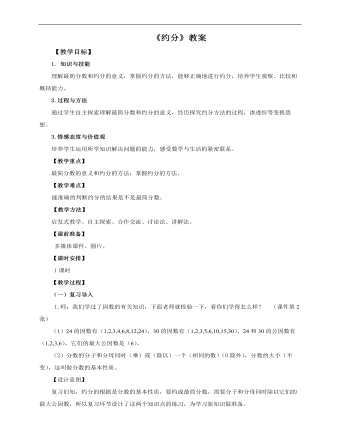
小学数学人教版五年级下册《第六课约分》教案说课稿
(一)复习导入 1.师:我们学过了因数的有关知识,下面老师就检验一下,看你们学得怎么样?(课件第2张)(1)24的因数有(1,2,3,4,6,8,12,24),30的因数有(1,2,3,5,6,10,15,30),24和30的公因数有(1,2,3,6),它们的最大公因数是(6)。(2)分数的分子和分母同时(乘)或(除以)一个(相同的数)(0除外),分数的大小(不变),这叫做分数的基本性质。【设计意图】复习旧知,约分的根据是分数的基本性质,要约成最简分数,需要分子和分母同时除以它们的最大公因数,所以复习环节设计了这两个知识点的练习,为学习新知识做准备。2.大家一定都喜欢孙悟空吧!你知道孙悟空最大的本事是什么吗?(72变)这节课我们就来创造第73变——变分数!(二)探究新知 1、探究约分的方法。(1)把化成分子和分母比较小且分数大小不变的分数。(课件第4张) 小组讨论:你是怎么想的?汇报交流(课件第5张)生1:可以用分子和分母的公因数(1除外)去除。生2:我用24和30的公因数2去除,,然后再用12和15的公因数3去除, 生3:我直接用24和30的最大公因数6去除。(2)用自己的话说说什么是约分?(课件第6张)生1:把一个分数化成和它相等,但分子和分母都比较小的分数,叫做约分。
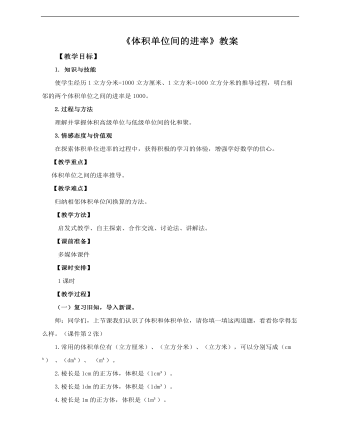
小学数学人教版五年级下册《第六课体积单位间的进率》教案说课稿
(一)复习旧知,导入新课。师:同学们,上节课我们认识了体积和体积单位,请你填一填这两道题,看看你学得怎么样。(课件第2张)1.常用的体积单位有(立方厘米)、(立方分米)、(立方米),可以分别写成(cm³) 、(dm³)、 (m³)。2.棱长是1cm的正方体,体积是(1cm³)。3.棱长是1dm的正方体,体积是(1dm³)。4.棱长是1m的正方体,体积是(1m³)。【设计意图】1dm³是多少cm³呢?这节课我们就来研究一下体积单位间的进率。(板书课题)(二)探究新知1.探究立方分米和立方厘米间的进率:(课件第3张)(1)下图是一个棱长为1dm的正方体,体积是1dm³。想一想,它的体积是多少立方厘米呢?(2)小组讨论,你是怎样想的?(3)汇报交流:(课件第4张)生1:如果把它的棱长看作是10cm,可以把它切成1000块1cm³的小正方体。10×10×10=1000.生2:它的底面积是1dm²,就是100cm²,100×10=1000,一共是1000cm³。1dm³=1000cm³【设计意图】用小组讨论的方式,让学生从讨论的过程中找到解决问题的方法,培养学生的语言表达能力、思维能力。2.你知道1m³等于多少立方分米吗?(课件第5张)生1:把棱长是1m的正方体,看作棱长是10dm的正方体,10×10×10=1000dm³。1m³=1000dm³。 生2:棱长是1m的正方体,底面积是1m²,就是100dm²,100×10=1000dm³,一共是1000dm³。生3:1m³=1000dm³ 3.整理计量单位之间的进率。(1)小组讨论:到现在为止,我们已经学习了哪些计量单位?请整理在表中。
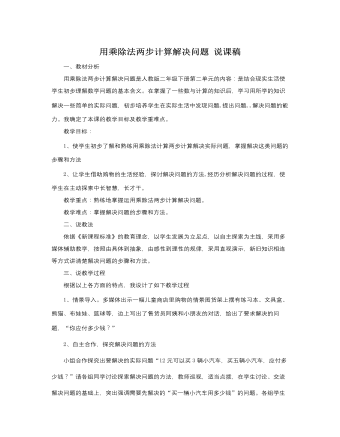
人教版新课标小学数学二年级下册用乘除法两步计算解决问题说课稿
例2是面包房买卖面包的情境。解决问题的重点是学会使用小括号列综合算式,并了解小括号的作用。通过学生熟悉的购买面包的情境,解决“还剩多少个”这个实际问题。仍然可以引导学生从不同的角度思考问题,启发列式为54-8-22或为54-(8+22)。第二种解法的综合算式,教材中特别强调“如果写成一个算式,应该使用小括号”,并明确“计算时先算小括号里面的”。因为是初次在列式时需要使用小括号,如果学生产生疑问,教师可组织学生通过回顾旧知,利用现实情境,明确使用小括号的必要性及使用方法。教学例2时可以采用与例1相似的教学方式。首先让学生观察下页图,也可以利用电教媒体创设情境,由学生提出问题,并启发学生思考如何解决。让学生充分交流研讨,畅谈自己的想法,然后着重说明解决问题的思路。列式计算时可以先分步列式,同时强调两种列式方法的内在联系,列综合算式时着重说明使用小括号的目的。
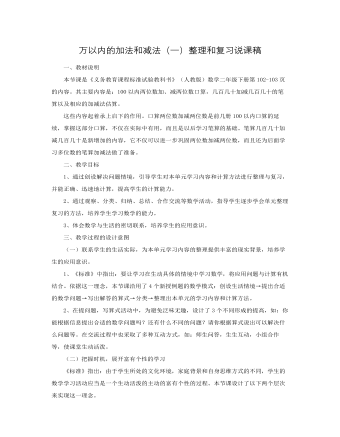
人教版新课标小学数学二年级下册万以内的加法和减法(一)整理和复习说课稿
三、估算度的把握。《标准》在计算教学方面强调的内容之一是重视估算,培养估算意识。我们认为重视估算,就是对学生数感的培养,具体体现在能估计运算的结果,并对结果的合理性作出解释。本节课的设计就是让学生在具体情境中,学会两种估算方法,结合具体情况作出合理解释。四、教会学生单元整理与复习的方法,使学生终身受益。我们知道授人以渔而非鱼的道理。在本节课中,老师设计了引导学生学会整理与复习的方法,如:带着问题看书,将算式分类、归纳、总结出本单元所学内容,计算方法,注意地方,最后进行有针对性的练习。如果我们的老师从小就有意识地对学生进行学习方法的培养,学生将终身受益。我想我们教学研讨活动就是为了实现教育的最高境界:今天的教是为了明天的不教。
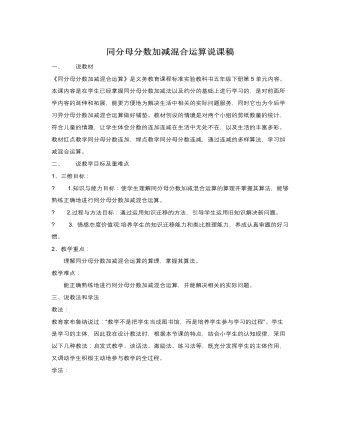
人教版新课标小学数学五年级下册同分母分数加减混合运算说课稿
4、简单小结,内化知识引导学生总结出学习的课题(教师板书),学生再明确表达出“同分母分数加减混合运算的顺序与证书加减混合运算的顺序完全相同,计算方法与同分母分数加减法的计算方法相同,即分母不变,分子相加减。注意能月份的一定要约成最简分数为止。”,(三)巩固练习、拓展应用1、基础练习2、引申练习3、解决实际问题 【精心设计练习,既有与例题程度相当的“保底”题,又有与生活密切相关的变式题,拓展思维,培养创新意识,展现数学的应用价值,让学生体会到学习数学有用,生活处处离不开数学。同时适时进行环保教育和爱国主义教育,起到了教书育人的作用。】五、说板书设计此板书力图板书的简洁美,能突出教学的重难点,提示了方法过程。
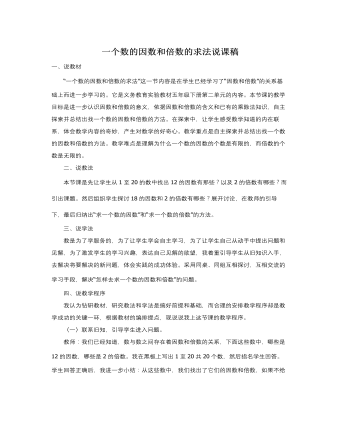
人教版新课标小学数学五年级下册一个数的因数和倍数的求法说课稿
在游戏中巩固知识,并体会区间套的数学思想,有利于培养学生的数感。做游戏时间不能过长,我只安排在4分钟内完成,让学生在学中乐和乐中学的兴趣。〈四〉全课总结今天这节课你们学了什么知识?有哪些收获?(让学生进行互说来结束本节课)五、说板书板书是体现课文内容脉落的载体。通过板书学生可以一目了然地弄请本节课你所授的内容知识的过程,让人永久深记,印象深刻。我的板书设计如下:一个数的因数和倍数的求法例1、18的因数有哪几个?18的因数有:1、2、3、6、9、18一个数的因数的个数是有限的,其中最小是1,最大的因数是它本身。方法:①哪两个自然数积等于18,则哪两个自然数就是这个数的因数。②哪个数能整除18,则哪个数就是这个数的因数。例2、2的倍数有哪些?一个数的倍数的个数是无限的,其中最小的倍数是它本身,没有最大的倍数。方法:用2与所有的自然数相乘,积就是它的倍数。
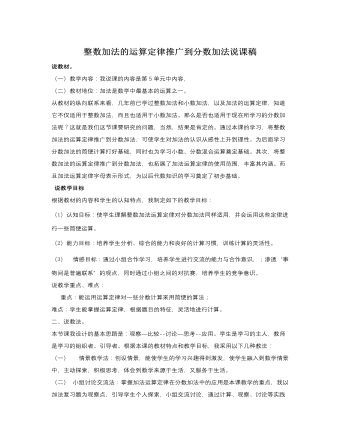
人教版新课标小学数学五年级下册整数加法的运算定律推广到分数加法说课稿
(一)教学内容:我说课的内容是第5单元中内容,(二)教材地位:加法是数学中最基本的运算之一。从教材的纵向联系来看,几年前已学过整数加法和小数加法,以及加法的运算定律,知道它不仅适用于整数加法,而且也适用于小数加法。那么是否也适用于现在所学习的分数加法呢?这就是我们这节课要研究的问题,当然,结果是肯定的。通过本课的学习,将整数加法的运算定律推广到分数加法,可使学生对加法的认识从感性上升到理性。为后面学习分数加法的简便计算打好基础,同时也为学习小数、分数混合运算奠定基础。其次,将整数加法的运算定律推广到分数加法,也拓展了加法运算定律的使用范围,丰富其内涵。而且加法运算定律字母表示形式,为以后代数知识的学习奠定了初步基础。
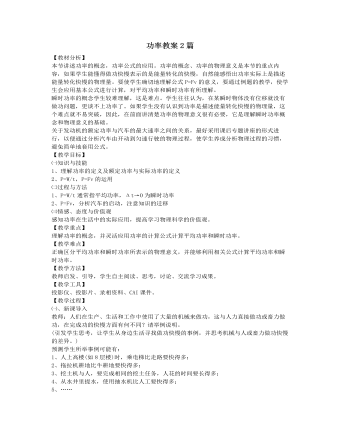
人教版新课标高中物理必修2功率教案2篇
1.用CAI课件模拟汽车的启动过程。师生共同讨论:①如果作用在物体上的力为恒力,且物体以匀速运动,则力对物体做功的功率保持不变。此情况下,任意一段时间内的平均功率与任一瞬时的瞬时功率都是相同的。②很多动力机器通常有一个额定功率,且通常使其在额定功率状态工作(如汽车),根据P=FV可知:当路面阻力较小时,牵引力也小,速度大,即汽车可以跑得快些;当路面阻力较大,或爬坡时,需要比较大的牵引力,速度必须小。这就是爬坡时汽车换低速挡的道理。③如果动力机器在实际功率小于额定功率的条件下工作,例如汽车刚刚起动后的一段时间内,速度逐渐增大过程中,牵引力仍可增大,即F和v可以同时增大,但是这一情况应以二者乘积等于额定功率为限度,即当实际功率大于额定功率以后,这种情况不可能实现。
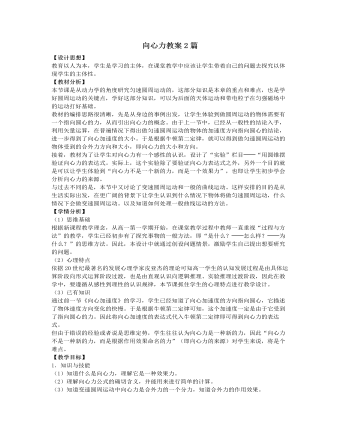
人教版新课标高中物理必修2向心力教案2篇
3.进一步体会力是产生加速度的原因,并通过牛顿第二定律来理解匀速圆周运动、变速圆周运动及一般曲线运动的各自特点。(三)、情感、态度与价值观1.在实验中,培养学生动手、探究的习惯。2.体会实验的意义,感受成功的快乐,激发学生探究问题的热情、乐于学习的品质。教学重点1.体会牛顿第二定律在向心力上的应用。2.明确向心力的意义、作用、公式及其变形,并经行计算。教学难点1.对向心力的理解及来源的寻找。2.运用向心力、向心加速度的知识解决圆周运动问题。教学过程(一)、 引入新课:复习提问:匀速圆周运动的物体的加速度——向心加速度,它的方向和大小有何特点呢?学生回答后进一步引导:那做匀速圆周运动物体的受力有什么特点呢?是什么力使物体做圆周运动而不沿直线飞出?请同学们先阅读教材
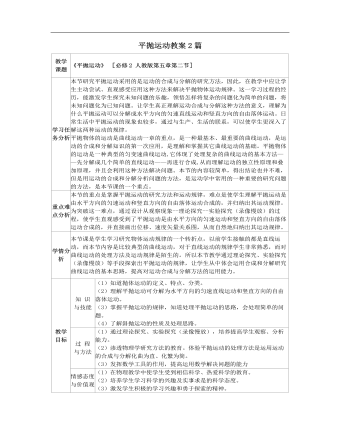
人教版新课标高中物理必修2平抛运动教案2篇
(五)平抛运动规律的应用例1:一架老式飞机在高出海面45m的高处,以80m/s的速度水平飞行,为了使飞机上投下的炸弹落在停在海面上的敌船,应该在与轰炸目标的水平距离为多远的地方投弹?不计空气阻力。分析:对于这道题我们可以从以下几个方面来考虑:(1)从水平飞行的飞机上投下的炸弹,做什么运动?为什么?(2)炸弹的这种运动可分解为哪两个什么样的分运动?3)要想使炸弹投到指定的目标处,你认为炸弹落地前在水平方向通过的距离与投弹时飞机离目标的水平距离之间有什么关系?拓展:1、式飞机在高出海面45m的高处,以80m/s的速度水平飞行,尾追一艘以15m/s逃逸的敌船,为了使飞机上投下的炸弹正好击中敌船,应该在与轰炸目标的水平距离为多远的地方投弹?不计空气阻力。2、在一次摩托车跨越壕沟的表演中,摩托车从壕沟的一侧以速度v=40m/s沿水平方向向另一侧,壕沟两侧的高度及宽度如图所示,摩托车可看做质点,不计空气阻力。(1)判断摩托车能否跨越壕沟?请计算说明(2)若能跨过,求落地速度?
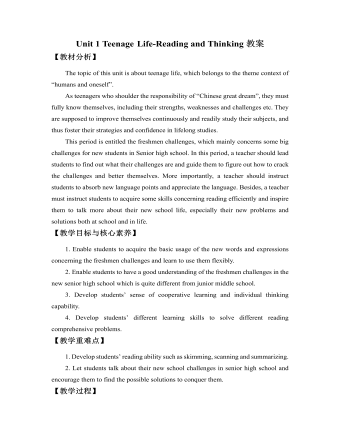
新人教版高中英语必修1Unit 1 Teenage Life-Reading and Thinking教案
【教材分析】The topic of this unit is about teenage life, which belongs to the theme context of “humans and oneself”.As teenagers who shoulder the responsibility of “Chinese great dream”, they must fully know themselves, including their strengths, weaknesses and challenges etc. They are supposed to improve themselves continuously and readily study their subjects, and thus foster their strategies and confidence in lifelong studies.This period is entitled the freshmen challenges, which mainly concerns some big challenges for new students in Senior high school. In this period, a teacher should lead students to find out what their challenges are and guide them to figure out how to crack the challenges and better themselves. More importantly, a teacher should instruct students to absorb new language points and appreciate the language. Besides, a teacher must instruct students to acquire some skills concerning reading efficiently and inspire them to talk more about their new school life, especially their new problems and solutions both at school and in life.【教学目标与核心素养】1. Enable students to acquire the basic usage of the new words and expressions concerning the freshmen challenges and learn to use them flexibly.2. Enable students to have a good understanding of the freshmen challenges in the new senior high school which is quite different from junior middle school.3. Develop students’ sense of cooperative learning and individual thinking capability. 4. Develop students’ different learning skills to solve different reading comprehensive problems.
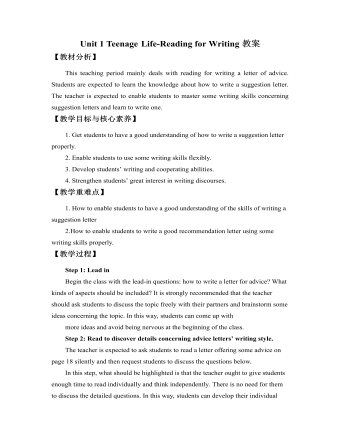
新人教版高中英语必修1Unit 1 Teenage Life-Reading for Writing教案
【教材分析】This teaching period mainly deals with reading for writing a letter of advice. Students are expected to learn the knowledge about how to write a suggestion letter. The teacher is expected to enable students to master some writing skills concerning suggestion letters and learn to write one.【教学目标与核心素养】1. Get students to have a good understanding of how to write a suggestion letter properly.2. Enable students to use some writing skills flexibly.3. Develop students’ writing and cooperating abilities.4. Strengthen students’ great interest in writing discourses.【教学重难点】1. How to enable students to have a good understanding of the skills of writing a suggestion letter2.How to enable students to write a good recommendation letter using some writing skills properly.【教学过程】Step 1: Lead in Begin the class with the lead-in questions: how to write a letter for advice? What kinds of aspects should be included? It is strongly recommended that the teacher should ask students to discuss the topic freely with their partners and brainstorm some ideas concerning the topic. In this way, students can come up with more ideas and avoid being nervous at the beginning of the class.Step 2: Read to discover details concerning advice letters’ writing style.The teacher is expected to ask students to read a letter offering some advice on page 18 silently and then request students to discuss the questions below.

新人教版高中英语必修1Unit 3 Sports and Fitness-Reading for Writing教案
Then have them write a short paragraph to describe and explain their changes. After that, get the Ss to exchange their drafts with their partners and use the checklist to give feedback on their drafts, and finally revise it.Step 5 Summary of how to write a wellness book1.健康书的审题步骤:第一步:明确要求该写作属于经验分享,故要用第一人称来写;时态以一股现在时为主。第二步:确定段落该类文章可以从以下三个方面人手:Para.1首先表明写作的目的Para.2自己的做法及心得体会Para.3表示期望及感谢第三步:提炼要点2.健康书常见句式:1) It is an honor for me to share my favorite sport with you,2) It makes me feel relaxed playing with my friends.3) It makes me rid myself of stress while playing with my friends.4) Moreover, it provides me a valuable chance to communicate with others.5) I we eat too little or too much, or if we choose the wrong food, we may become sick.6) We can do something to change the poor situation.Step 6Homework假如你的老师让你在班级Wellness Bok上分享自己的亲身经历及心得,请根据以下要点写一篇80字左右的文章1. 你喜欢的运动是什么?2. 你最喜欢的原因是什么?3. 你参加锻炼的体会。
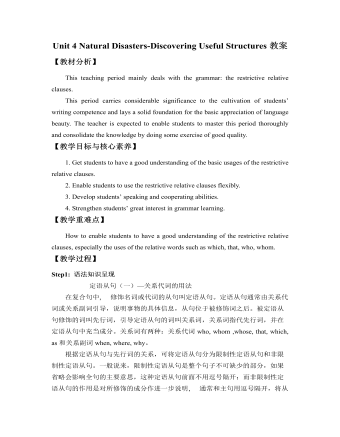
新人教版高中英语必修1Unit 4 Natural Disasters-Discovering Useful Structures教案
【教材分析】This teaching period mainly deals with the grammar: the restrictive relative clauses.This period carries considerable significance to the cultivation of students’ writing competence and lays a solid foundation for the basic appreciation of language beauty. The teacher is expected to enable students to master this period thoroughly and consolidate the knowledge by doing some exercise of good quality.【教学目标与核心素养】1. Get students to have a good understanding of the basic usages of the restrictive relative clauses.2. Enable students to use the restrictive relative clauses flexibly.3. Develop students’ speaking and cooperating abilities.4. Strengthen students’ great interest in grammar learning.【教学重难点】How to enable students to have a good understanding of the restrictive relative clauses, especially the uses of the relative words such as which, that, who, whom.【教学过程】Step1: 语法知识呈现定语从句(一)—关系代词的用法在复合句中, 修饰名词或代词的从句叫定语从句。定语从句通常由关系代词或关系副词引导,说明事物的具体信息,从句位于被修饰词之后。被定语从句修饰的词叫先行词,引导定语从句的词叫关系词,关系词指代先行词,并在定语从句中充当成分。关系词有两种:关系代词who, whom ,whose, that, which, as和关系副词when, where, why。

新人教版高中英语必修1Unit 4 Natural Disasters-Reading & Thinking教案
5. Read to get detailed information about Paragraph 5.Q1. What shows the revival of Tangshan?Q2. How can Tangshan revive itself and get up on its feet again?Q3. In times of disasters, how can we go through it?T: In times of disasters, we should unify, show the wisdom and stay positive.Step 4 Activity 4 Highlighting the theme and reflecting1. Make a summary of the text.2. Further understand the titleQ: After our learning, why do you think the earth didn’t sleep on that night?T: An earthquake happened. The people in the earthquake suffered a lot, and the people outside Tangshan were concerned about the people there a lot.3. Reflect through discussion on what can be learnt after reading.T: Disasters are powerful. Unpreparedness can be deadly. Life is weak, but if people work together to help each other, disasters can be defeated.There is no love from disaster, but we have love in the human heart.Step 5 Assignment How does the writer convey that the earthquake was deadly, and that people were helpless during the earthquake? Try to find some attractive and impressive expressions and note them down.
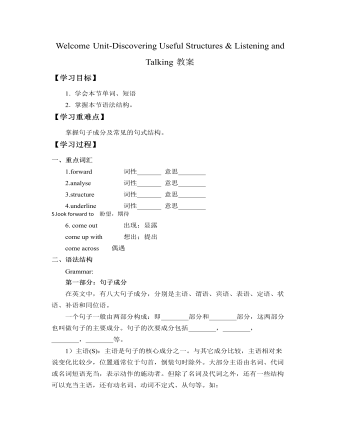
新人教版高中英语必修1Welcome Unit-Discovering Useful Structures & Listening and Talking教案
常跟双宾语的动词有:(需借助to的)bring, ask, hand, offer, give, lend, send, show, teach, tell, write, pass, pay, promise, return等;基本句型 五S +V + O + OC(主+谓+宾+宾补)特点:动词虽然是及物动词,但是只跟一个宾语还不能表达完整的意思,必须加上一个补充成分来补足宾语,才能使意思完整。 判断原则:能表达成—宾语 是…/做…注:此结构由“主语+及物的谓语动词+宾语+宾语补足语”构成。宾语与宾语补足语之间有逻辑上的主谓关系或主表关系,若无宾语补足语,则句意不够完整。可以用做宾补的有:名词,形容词,副词,介词短语,动词不定式,分词等。如:He considers himself an expert on the subject.他认为自己是这门学科的专家。We must keep our classroom clean.我们必须保持教室清洁。I had my bike stolen.我的自行车被偷了。We invited him to come to our school.我们邀请他来我们学校。I beg you to keep secret what we talked here.我求你对这里所谈的话保密。用it做形式宾语,而将真正的宾语放到宾语补足语的后面,以使句子结构平衡,是英语常用的句型结构方式。即:主语+谓语+it+宾补+真正宾语。如:We think it a good idea to go climb the mountain this Sunday.

新人教版高中英语必修1Unit 5 Languages Around the World-Reading and Thinking教案
【教材分析】本节课是高中英语第一册的最后一个单元的阅读和思考部分,文章难度明显增加,体现在以下几个方面:文章题材是说明文,比较难理解;话题生疏,涉及到历史等知识;生词量增大,而且在语境中理解词汇的要求提高。面对这些,教师的难度和高度也要有所提升,通过探讨说明顺序,了解背景知识等帮助他们找到说明文阅读的方法。【教学目标与核心素养】1. 文化意识目标新课程中指出,文化意识是对中外文化的理解和对优秀文化的认同。文化意识的的培养有助于学生增加国家认同和家国情怀,成为有文明素养和社会责任感的人。我们这个单元很好体现了这一点,通过了解汉字书写的体系和发展,学生可以有一种文化自豪感,同时也能够帮助学生深入挖掘这篇文章,从而想到更多和中国文化相关的方面。2. 学习能力目标
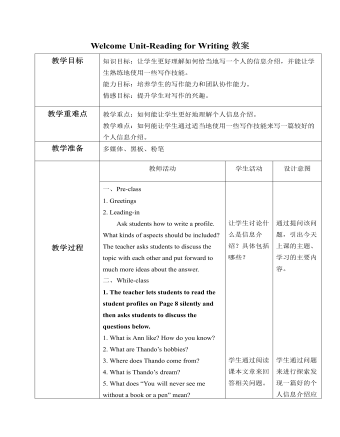
新人教版高中英语必修1Welcome Unit-Reading for Writing教案
教学目标知识目标:让学生更好理解如何恰当地写一个人的信息介绍,并能让学生熟练地使用一些写作技能。能力目标:培养学生的写作能力和团队协作能力。情感目标:提升学生对写作的兴趣。教学重难点 教学重点:如何能让学生更好地理解个人信息介绍。教学难点:如何能让学生通过适当地使用一些写作技能来写一篇较好的个人信息介绍。教学准备 多媒体、黑板、粉笔一、Pre-class1. Greetings2. Leading-inAsk students how to write a profile. What kinds of aspects should be included? The teacher asks students to discuss the topic with each other and put forward to much more ideas about the answer.二、While-class1. The teacher lets students to read the student profiles on Page 8 silently and then asks students to discuss the questions below.1. What is Ann like? How do you know?2. What are Thando’s hobbies?3. Where does Thando come from?4. What is Thando’s dream?5. What does “You will never see me without a book or a pen” mean?

新人教版高中英语选修4Unit 1 Science Fiction教案
本活动旨在落实课时教学目标2。 1.Think, discuss and share. Students form groups of 4, discuss about the given ending make comments. Q1: Do you like the ending? Q2: Was it a logical ending? Why so or why not? [设计意图]通过引导学生思考、讨论、评价,比较个人、同伴所预测的结局和听力文本所给定的结局的异同点,深化对文本的认知,发展学生的评判性思维能力。 Activity 4: Exploring Asimov’s three laws of robotics and the purpose of the writing 本活动旨在落实课时教学目标3。 1. Get to know Isaac Asimov’s three laws of robotics. The teacher shares Isaac Asimov’s three laws of robotics. The three laws state that: ①A robot may not injure a human being or, through inaction, allow a human being to come to harm. ②A robot must obey any orders given to it by human beings, except where such orders would conflict with the First Law. ③A robot must protect its own existence as long as such protection does not conflict with the First or Second Law. Q: How does Tony’s story relate to the laws? 2. Figure out Isaac Asimov’s purpose of writing Satisfaction Guaranteed. The students express their opinions about the author’s writing purpose. Q: Why did Isaac Asimov write such a story? S: To explore the relationship between robots and humans. [设计意图]通过了解艾萨克·阿西莫夫所制定的机器人三大定律,加深学生对文本的理解,深入探究文本的主题意义。推理作者的写作目的,联系生活实际,思考人类与机器人的关系。

新人教版高中英语选修3Unit 5 Poems教案
本单元阅读文本介绍了几种简单的英语诗歌形式,旨在让学生能理解和欣赏英语诗歌的美,包括形式美、内容美、意义美,培养审美情趣,并从作品的意义美中获得积极的人生态度和价值观念启示。 该文本是一则典型的说明性文本,用简单易懂的语言向英语诗歌的初学者们介绍了五种比较简单的英语诗歌形式。文题“A Few Simple Forms of English Poems”是整个文本的核心话题。正文内容共七段,按“总—分—总”建构。第一段为总起段,概述了英语诗歌的创作原因以及主要特点,涉及了形式、内容、意义等方面赏析英语诗歌的几个主要维度;第二段至第六段分别介绍了童谣、清单诗、五行诗、俳句和唐诗五种英语诗歌形式;第七段收尾,鼓励读者尝试英语诗歌创作。 在进行文本教学设计时,要引导学生梳理关于与诗歌要素和诗歌赏析有关的话题类语言,既包括format、rhythm、subject、image等名词,也包括have a strong rhythm、be made up of、contain、consist of、convey这样的动词和动词短语。

